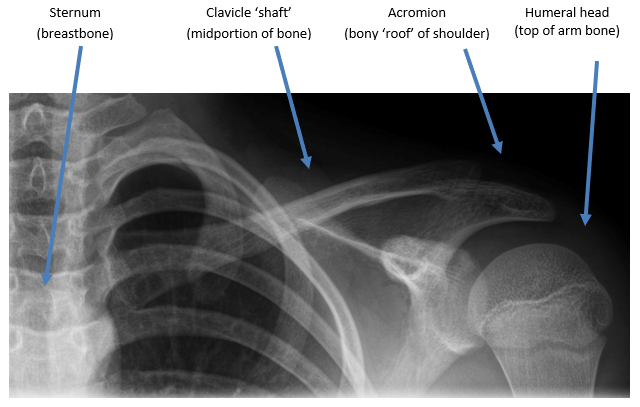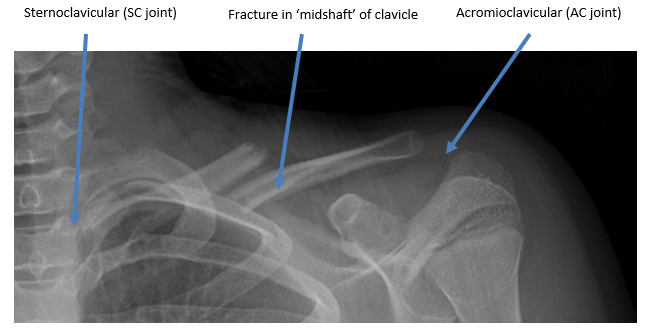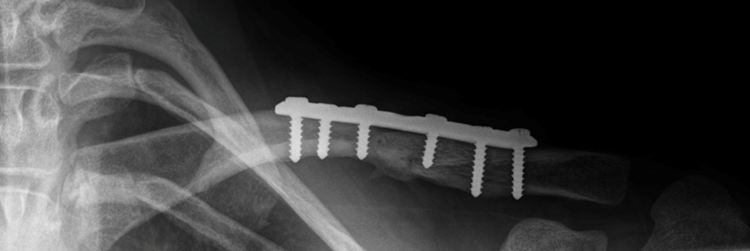
 POSNA.org
POSNA.org


Clavicle fractures are treated based on whether there is a complete break in the bone, how many fragments (broken pieces ) there, how the fragments are aligned, as well as the age of the child. The vast majority of clavicle fractures in children can be treated with a simple shoulder sling and a period of rest to allow the bone to heal.
In older adolescents, there is still some controversy regarding whether there may be some benefit to doing surgery for complete breaks in which the fractured pieces have slid past each other significantly, which is referred to as ‘shortening’. This controversy stems from the fact that some studies in the past 10-15 years have suggested that surgery may be beneficial to adults, in terms of overall shoulder function, when there are multiple fragments to the fracture or severe shortening of the broken fragments of the clavicle. As older adolescents may be similar to young adults in the way their bones heal and their shoulder functions, they too may benefit from surgery. Newer studies that have focused specifically on these fractures in adolescents, however, have suggested that the presumed benefit from surgery may not be same for this younger age group, and, in fact, that surgery has more risks to an adolescent than letting the bone heal on its own. While more research is ongoing on this subject, it is reasonable to have an informed discussion with your orthopedic surgeon to see what he/she feels may be best option for the long term health of the shoulder.
The first 2 weeks following a clavicle fracture can be painful, so use of a shoulder sling most of the time is helpful. Sometimes, doctors will get a new x-ray 2-4 weeks following the injury. From weeks 2 to 6 after the injury, the pain tends to improve, and movement and use of the arm will improve. While the sling may no longer be needed at home, some doctors will recommend sending kids to school with the sling to help remind the patient, their friends, and their teachers/coaches that there are still restrictions that should be followed to avoid re-injury. Your doctor will decide when your child may safely return to sports and normal activities, usually sometime between 2-3 months after the injury.
Surgery may be needed early for a clavicle fracture if there is significant stretch of the skin by one of the broken bone edges, or if the bone does not show signs of healing over time, which is extremely rare. If surgery is needed, it is usually performed through a single incision (cut in the skin) just below the clavicle, with placement of a metal plate and screws to hold the broken pieces in place while the bone heals (as seen below).

Sometimes, the plate and screws end up being painful or uncomfortable over time, even after the bone heals completely. Studies have suggested this occurs in 5-20% of adolescents who undergo the surgery. In these scenarios, a small procedure to remove the plate and screws can be performed, which generally eliminates the pain. However, enough time should be planned after the procedure to remain out of contact sports, such as football or lacrosse, to avoid the bone from breaking again, which can occur through one of the holes where the screws had previously been. Within several months, the holes fill in with new bone, and the risk of this re-injury goes down.
Most children recover completely from their clavicle fractures within a few months. A sling is generally used for 2-8 weeks, after which time arm function can return to normal, with strength exercises slowly being resumed, though formal physical therapy appointments are usually not required.
In most cases, the bone needs around 3 full months to undergo more advanced, or complete, healing. Therefore, activities in which there is significant risk of falls, as well as contact sports, such as football, hockey, or lacrosse, should be delayed or modified until an additional radiograph has shown that the bone is ready for such activities without a significant risk of re-fracture.
Children are not little adults, but like adults, they need expert care. A pediatric orthopedic surgeon will have experience in managing these injuries in children and adolescents in order to make the sure the fracture is adequately aligned, to decrease the risk of complications, and increase the likelihood of a good outcome.
Page QR Code:

Patients with this injury have a high rate of healing, and they almost always return to their previous level of activity before they were injured. Occasionally, physical therapy may be helpful in regaining some of the muscle strength or use the arm more normally during the healing process.
When a plate and screws are placed as part of surgery, they are usually intended to stay in for good, as they do not cause any long-term harm to the bone or the body. However, if the plate and screws prove to be irritating or painful over time, an implant removal surgery can be planned at some point, and is generally thought to be a low-risk procedure with a quick recovery. Secondary surgery to remove clavicle plates and screws has been reported in between 5-20% of young populations who undergo surgery. Pursuing this type of surgery is a shared decision with your surgeon. If the implants are removed, this typically occurs well after the fracture is completely healed, usually greater than 6 months after the injury.
Clavicle fractures generally heal enough to be stable and allow normal arm and shoulder use as early as 6-8 weeks, depending on the severity, but complete healing can take up to 3-4 months. Return to basic activities and contact sports should therefore be determined by your surgeon based on the facture healing, and to what activities your child may want to return. Return to activities before complete healing can lead to repeat injury or re-fracture.
Most children can return to activity without formal physical therapy. Older patients, patients returning to high-level sports, and/or patients with a prolonged time for healing may occasionally benefit from physical therapy to optimize their return to activities.
Return to normal function of the shoulder and a normal feeling with higher-level overhead activities sometimes occurs within 1-2 months after the fracture, but instead may take several months. Because of a young person’s ability for their bone to keep healing or ‘remodeling’ over time, it is very rare for a patient to be permanently left with a shoulder that feels different from the other side or doesn’t feel ‘right’. Physical therapy can be helpful in these instances.
Sometimes, the extra bone formed by your child’s body to heal a clavicle fracture will give the appearance of a ‘bump’. This is usually a temporary appearance because the bone is still in the process of growing. The clavicle is actually the last bone in the body to finish growing, continuing into one’s 20’s, so improvement in the appearance can occur even for older adolescents who are not growing in height any more. This process, referred to as ‘remodeling’, is the body’s way of smoothing out bumps in the bone or straightening out a bone that is not quite straight after a fracture. If the bump is particularly bothersome, a minor surgical procedure could be done to smooth out the bump, but patients should be aware that they would be trading a bump for a scar, because the procedure would require an incision in the skin. Similarly, performing surgery for a clavicle fracture soon after the injury would also minimize the chance of forming a bump in the first place, but one would also be trading a bump for a scar, as well as the risk of the plate and screws creating discomfort or prominence themselves.
How quickly children are returned to sports after a clavicle fracture depends on the speed of healing and your doctor’s protocols for resuming activities. There are some studies that have suggested that return to sports may be faster with surgery, compared to letting the clavicle bone heal on its own. However, the difference in time has been shown to be fairly minimal, in the range of 1-3 weeks. Because studies have also shown that the risk of complications and unexpected or additional procedures is greater when surgery is used for clavicle fractures, each family should consider the balance of risks and benefits for each form of treatment.
Benton E. Heyworth, MD
POSNA Trauma QSVI Committee